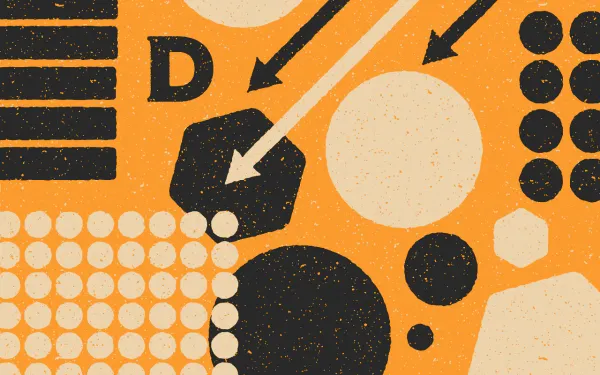Turn the Character Sheet Sideways
Tips & tricks for designing character sheets.

Wow, what a character.
Don’t judge a game by its cover. Judge games by their character sheets. Character sheets usually say everything you need to know about a game—and they do it with a fraction of the words and purple prose.
In my experience, good games almost always have great character sheets. Or compelling ones anyway. As for the opposite scenario? A death sentence. This is why I’m going to share my very objective, not at all personal, true as gravity tips and tricks.
1. The character sheet is a distillation.
Yeah, that’s right. The first tip is pedantic as hell. If you want a good character sheet, you need to know what your game is actually about. That means deciding on a theme and core rules and killing all your darlings who get in the way.
You’ll have to pull the proverbial rabbit from the hat if you don't do this. For example, if your entire game is modular, you might need to make a modular character sheet. If you’re not up for that kind of challenge, return to the top of this section.
Condense. Distill. Separate the signal from the noise and pump up the volume.
Fun bonus tip: Start with the character sheet before anything else. Then, use the character sheet like it’s an outline, brief, or thesis. If you can get the idea of the game into the player-facing handout—you’re golden.
2. Remove anything a Post-it can do better.
Traditional character sheets include lots of sections that are agonizing to use. Picture in your mind’s eye the D&D hit points section, the minuscule OSR inventory section, and the dreaded “conditions box.”
Do you like erasing things on a page whenever you have to update it? What is your experience with erasers? That’s a lottery I never win. I always get the pink eraser made of chalk and cardboard.
Lots of elements seldom change, like maximum health, inventory space, and character attributes. Those can stay. The rest can have rule reminders, outlines, or nods. For example, you can have an inventory section for how your character is carting all of their stuff, where it is, and why they have it—but the shipping manifest can live on a separate piece of paper if it’s going to change several times in a session.
3. Turn that character sheet sideways.
Many character sheets are on A4 or US letter in the traditional portrait orientation. Your game would probably benefit from that character sheet being turned sideways. This is for a couple reasons.
- The sideways character sheet takes up less space from the center of the game table. This means more space and less clutter for food, drinks, maps, and play aids. Is it a small difference? Absolutely. Do a lot of people play on tiny tables? Absolutely.
- Portrait layout can only give you two columns to comfortably write notes in. Any additional columns or sub-modules become very cramped very quickly. There’s also something to be said for the way a tall page subdivides. When your page is horizontal you get more left-to-right progression without sacrificing your top-to-bottom architecture. This means different facets of a character are more easily separated and broken across the page when it’s horizontal. In the portrait orientation, there’s a greater emphasis on top-to-bottom progression which can literally bury parts of your character at the bottom of the page.
4. Leave open spaces. Don’t fill them in.
A lot of character sheets look like sexy tax forms. The problem is that none of these games are about doing your taxes—so why look like that? Don’t separate things with lines that can just as easily be separated by consistent use of spacing.
Does your character sheet have a list of attributes? Strongly reconsider making each attribute a box with those claustrophobic box boundaries.
Making a miscellaneous notes section? Don’t put big thick lines there for writing on when an empty box will do. It saves ink and allows the player to write as big or as small as they like. You know what happened when I didn’t put lines in the inventory section? The player drew pictures of their equipment. They loved it. I loved it. Everyone was engaged.
Leave empty space. Make the character sheet open to other approaches. If you distilled your game and did everything else on this list, you won’t have to sacrifice anything.
5. Get weird with it.
The character sheet evangelizes the game. Put cool stuff into it to get people excited. If your game is all about technical stuff, like lockpicking or mech operation, make your character sheet interactable. If you are making a death metal RPG, make the character sheet dirty and gory.
Be weird. The character sheet sets a mood. So you should be asking yourself, “What can I do to make that mood unique?”
Conclusion
This is the part where I have to show some proof. What are good examples of RPGs with great character sheets? Here’s a quick list for all of you fellow cynics.
Blades in the Dark. It’s denser than the ink-dark sea of Duskvol, but it has a number of toy-like boxes and meters to play with. Very weird. Very thematic. Highly recommended.
Mothership. The Mothership character sheet is famously a flowchart. That doesn’t necessarily make it super useful or clean. The game’s rules are fiddly, and the flowchart has to make a lot of tight turns to get you through them. But what it doesn’t achieve in perfect execution, it more than makes up for in style and ludonarrative resonance. It’s a gritty sci-fi horror game with a flowchart! What a vibe.
Mausritter. A simple rules-lite game that puts its big, weird thing front and center. The inventory system is a tile-like mini game of literally trying to fit things into the pack.
MÖRK BORG. It’s famous for a reason. The game never misses an opportunity to show off its style. It’s a flail to the face and the character sheet is no different.
Bruno Prosaiko. The absolute best at making character sheets into thematic illustrations. I think Bruno’s work is only possible when the game’s themes and idea are dialed down to a minimalist shiv. An excellent illustrator as well.
Until next time, never stop exploring.




